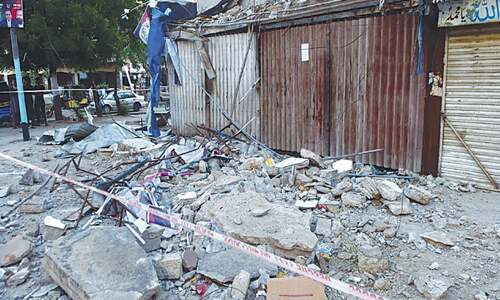
KARACHI: After the shocking death of 46-year-old black American George Floyd on May 25 at the hands of a white policeman, the Black Lives Matter movement in the US and Europe has once again, this time around perhaps in a more concrete way, given the entire world a chance to reflect upon the unsavoury parts of our collective history.
The movement is putting pressure on authorities to revisit history and bring about necessary reforms to improve the criminal justice system and put in place laws that can end discrimination against minorities. To drive their point home, the protestors in the US and UK have uprooted statues and other monuments to individuals depicting their societies’ racist past. On the second day of protest, slave trader Edward Colston’s statue was torn down in Bristol and chucked into the harbour. The images of uprooting the figure went viral in no time.
Karachi, with the city’s colonial maazi, has had its fair share of monuments, some of them carved in marble. Interestingly, and it doesn’t matter which side of history you stand, a majority of them have disappeared from their original places.
There used to be an obelisk near the Native Jetty Bridge that reminded everyone of Napier’s rule. Where it went is anybody’s guess
It has been documented that Queen Victoria and Prince Albert’s statues, among several others, were removed in the 1960s when Gen Ayub Khan ruled the country to prevent the ire of right-wing forces prior to the visit of a leader of a Muslim country. Those sculptures were plopped into the warehouse of the Karachi Municipal Corporation (KMC) and in a certain section of the Karachi Water and Sewerage Board (KWSB) building. Attempts, ever since, have been made to restore some of them.
It has to be said, though, that when it comes to Sindh in general and Karachi in particular the first British name that springs to mind without thinking twice is of Charles Napier, because he was the one who conquered the province in the early 1840s — remember the phrase “I have sinned!” So the logical question that history buffs need to ask with reference to monuments in Karachi: was there ever a Napier statue, such as the one in Trafalgar Square in London, in the Sindh capital? Difficult to answer. What can be said with certainty is that until a few years after the country’s independence, there used to be an obelisk near the Native Jetty Bridge that reminded everyone of Napier’s rule in the region. Where it went is anybody’s guess. Probably, someone who didn’t like to be reminded of the British Raj took it away. Probably.
But then there were personalities bigger in royal stature than Napier; for example, Queen Victoria, whose, it seems, more than one statue adorned the city’s important pre-independence works of stonemasonry. Architect Dr Noman Ahmed says, “Her statue was a prominent feature of Frere Hall [premises]. It disappeared a few months following the creation of Pakistan. There was a statue of architect James Stratchen, which too does not exist anymore. Its picture, however, can be seen at the municipality building.

“Sculpture making is an art. Those who designed buildings in colonial times took it as an essential art form, so much so that there were some buildings in which pedestals for statues were designed before the main structure because it increased the aesthetic value of its central or external elevation. They were part of a ‘planned activity’, as it happened in Frere Hall’s case. Similarly, the NED University building used to have a statue of Nadirshah Eduljee Dinshaw which was removed some years back,” says Dr Ahmed.
Hamid Akhund, secretary of the Endowment Fund Trust for Preservation of the Heritage of Sindh, says, “I remember the statue of Mahatma Gandhi in the Karachi Chamber of Commerce building. I don’t know where it’s gone. There were also some statues thrown away by the KMC, such as one of Queen Victoria and brass justice statues, which we retrieved and cleaned when we did the Jewel in the Crown exhibition. They’re now at the Mohatta Palace Museum. The Mama Parsi School and another Parsi school across that road, too, have statues.”
All of this reiterates the fact that Karachi has always been an aesthetically rich town whose beauty is not mutually exclusive to its history.
Published in Dawn, June 16th, 2020














































Dear visitor, the comments section is undergoing an overhaul and will return soon.